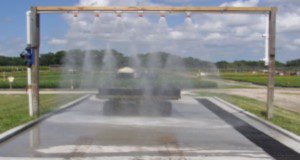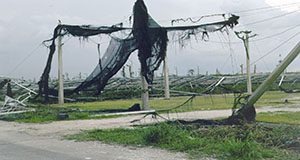Watering stations are specialized irrigation structures where plants are watered immediately after transplanting. Water not retained by the container substrate as well as water falling between containers becomes runoff. This runoff can contain sediment and nutrients, such as nitrogen and phosphorus, that can impact natural waters if not managed according to Best Management Practices (BMPs). The purpose of this new 3-page fact sheet is to provide examples of how runoff from watering stations at two nurseries was managed after implementation of the BMP. Written by Tom Yeager and published by the UF/IFAS Environmental Horticulture Department.
https://edis.ifas.ufl.edu/ep590
Tag: Tom Yeager
Hurricane Preparation List for the Container Nursery
Busy professionals don’t often have time to consider the impact a hurricane can have on their nursery until one is on the way. This 2-page fact sheet provides a list of items and tasks to complete prior to a hurricane’s arrival to minimize damage to the nursery. Written by Tom Yeager and published by the UF/IFAS Environmental Horticulture Department, December 2017.
http://edis.ifas.ufl.edu/ep547
Monitoring Leaching Fraction for Irrigation Scheduling in Container Nurseries

Scheduling irrigation in container nurseries can be a daunting task for producers. There is a great risk of under- or over-watering. The leaching fraction (LF) test is a valuable tool for measuring the volume of container drainage collected during irrigation relative to the volume of water entering the container. With this test, producers can adjust their irrigation to maintain a low percentage of leaching. This four-page fact sheet explains how to perform the test, gives example calculations, and provides some suggestions on how to utilize LF testing when managing irrigation. Written by Jeff Million and Tom Yeager, and published by the Environmental Horticulture Department.
http://edis.ifas.ufl.edu/ep529
Nursery Irrigation System Checklist (ENH1208/EP469)
 Irrigation must be intensively managed to achieve optimal production times for plants of superior quality. There must be a balance between excessive and inadequate irrigation. Producers use irrigation control devices and past experience to achieve the balance. A few simple checks before and during irrigation can make a big difference in efficient and uniform delivery of the appropriate amount of water. This 4-page fact sheet was written by Tom Yeager, and published by the UF Department of Environmental Horticulture, April 2013.
Irrigation must be intensively managed to achieve optimal production times for plants of superior quality. There must be a balance between excessive and inadequate irrigation. Producers use irrigation control devices and past experience to achieve the balance. A few simple checks before and during irrigation can make a big difference in efficient and uniform delivery of the appropriate amount of water. This 4-page fact sheet was written by Tom Yeager, and published by the UF Department of Environmental Horticulture, April 2013.
http://edis.ifas.ufl.edu/ep469
Measuring the Irrigation Requirement of Container-Grown Nursery Plants (ENH1197/EP458)
 Three factors determine the irrigation requirement for container-grown crops: evapotranspiration, capture factor, and distribution uniformity. This 4-page fact sheet describes how these factors can be measured so that irrigation requirements can be determined in the container nursery. Written by Jeff Million and Tom Yeager, and published by the UF Department of Environmental Horticulture, June 2012.
Three factors determine the irrigation requirement for container-grown crops: evapotranspiration, capture factor, and distribution uniformity. This 4-page fact sheet describes how these factors can be measured so that irrigation requirements can be determined in the container nursery. Written by Jeff Million and Tom Yeager, and published by the UF Department of Environmental Horticulture, June 2012.
http://edis.ifas.ufl.edu/ep458
ENH1119/EP384 Use of Reclaimed Water for Irrigation in Container Nurseries
ENH-1119, an 8-page illustrated fact sheet by Tom Yeager, Claudia Larsen, Joe von Merveldt, and Tracy Irani, informs container nursery producers about irrigating with water processed from municipal sewage wastewater, the results of evaluations of overhead sprinkler irrigation systems, where to get it, and special application procedures and cautions. Includes references and a glossary. Published by the UF Department of Environmental Horticulture, May 2009.
http://edis.ifas.ufl.edu/EP384

